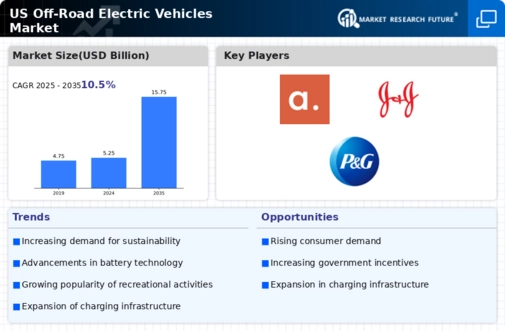Advancements in Charging Infrastructure
The off road-electric-vehicles market is benefiting from significant advancements in charging infrastructure across the United States. As more charging stations become available in remote areas, the feasibility of using electric vehicles for off-road adventures increases. Recent data suggests that the number of charging stations has grown by over 30% in the past year, facilitating easier access for consumers. This development not only enhances the convenience of owning an electric off-road vehicle but also alleviates range anxiety among potential buyers. The expansion of charging networks is expected to play a crucial role in the off road-electric-vehicles market, as it encourages adoption and usage. As infrastructure continues to improve, it is likely that more consumers will consider electric options for their off-road needs, further driving market growth.
Environmental Regulations and Standards
The off road-electric-vehicles market is significantly influenced by stringent environmental regulations and standards imposed by government agencies. In an effort to reduce emissions and promote sustainability, various states have enacted laws that encourage the use of electric vehicles. For instance, incentives such as tax credits and rebates for electric vehicle purchases are becoming more common, potentially increasing market penetration. As of 2025, it is estimated that compliance with these regulations could lead to a 20% increase in the adoption of electric off-road vehicles. This regulatory landscape not only supports the growth of the off road-electric-vehicles market but also compels manufacturers to innovate and develop cleaner technologies. Consequently, the alignment of market offerings with regulatory requirements is likely to enhance competitiveness and consumer appeal.
Rising Fuel Prices and Economic Factors
The off road-electric-vehicles market is also being shaped by rising fuel prices and broader economic factors. As gasoline prices fluctuate, consumers are increasingly seeking cost-effective alternatives for their off-road transportation needs. The total cost of ownership for electric vehicles is becoming more attractive, especially as fuel prices remain volatile. In 2025, it is projected that the cost savings associated with electric vehicles could lead to a 10% increase in market demand. This economic shift encourages consumers to consider electric options, thereby driving growth in the off road-electric-vehicles market. Additionally, as the economy continues to evolve, the financial incentives associated with electric vehicles may further enhance their appeal, making them a viable choice for off-road enthusiasts.
Increasing Off-Road Recreational Activities
The off road-electric-vehicles market is experiencing a surge in demand due to the increasing popularity of off-road recreational activities. As outdoor enthusiasts seek eco-friendly alternatives, electric vehicles designed for rugged terrains are gaining traction. In 2025, the market is projected to grow by approximately 15%, driven by a rise in adventure tourism and recreational vehicle usage. This trend indicates a shift towards sustainable leisure activities, where consumers prioritize environmental impact. The off road-electric-vehicles market is well-positioned to capitalize on this growing interest, as manufacturers innovate to meet the needs of this expanding demographic. Furthermore, the integration of advanced features such as enhanced battery life and terrain adaptability is likely to attract more consumers, thereby bolstering market growth.
Technological Innovations in Vehicle Design
The off road-electric-vehicles market is witnessing a wave of technological innovations in vehicle design, which are enhancing performance and user experience. Manufacturers are increasingly focusing on developing lightweight materials and advanced engineering techniques to improve the efficiency and durability of electric off-road vehicles. Innovations such as regenerative braking and enhanced suspension systems are becoming standard features, appealing to a broader audience. In 2025, it is anticipated that these advancements could lead to a 25% increase in consumer interest in electric off-road vehicles. As technology continues to evolve, the off road-electric-vehicles market is likely to benefit from improved vehicle capabilities, making them more attractive to both recreational users and professional operators.














Leave a Comment